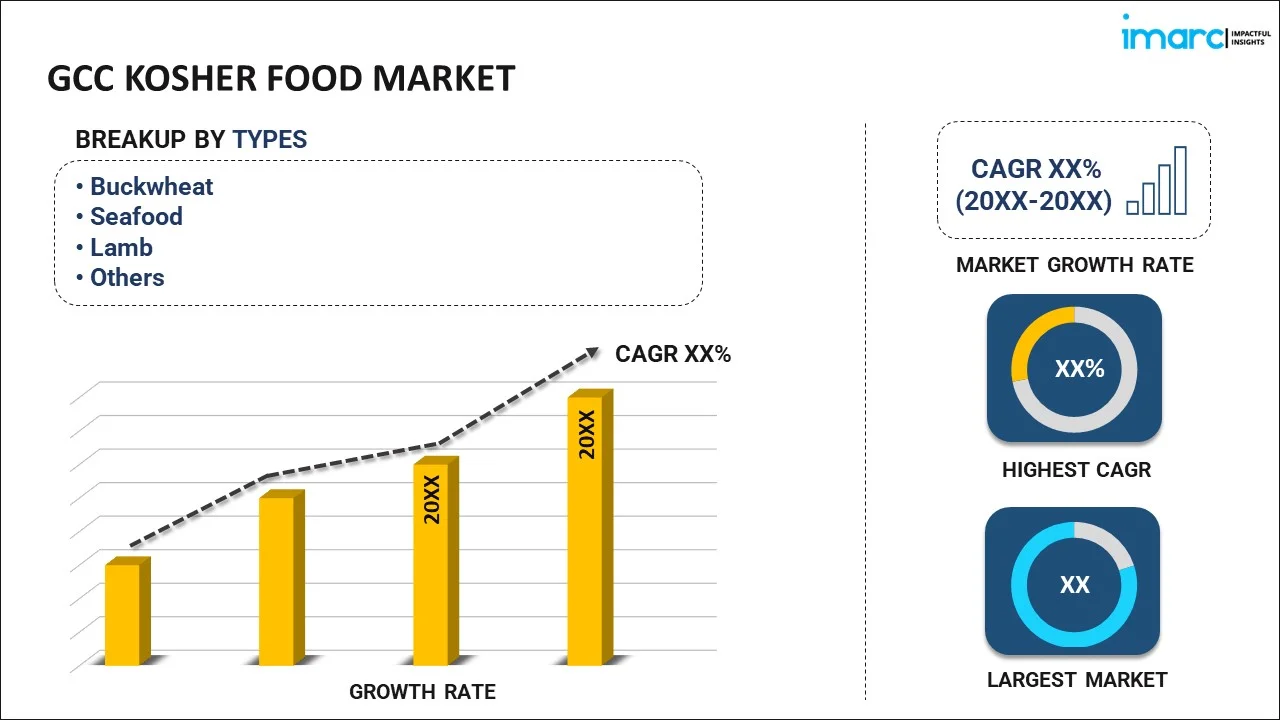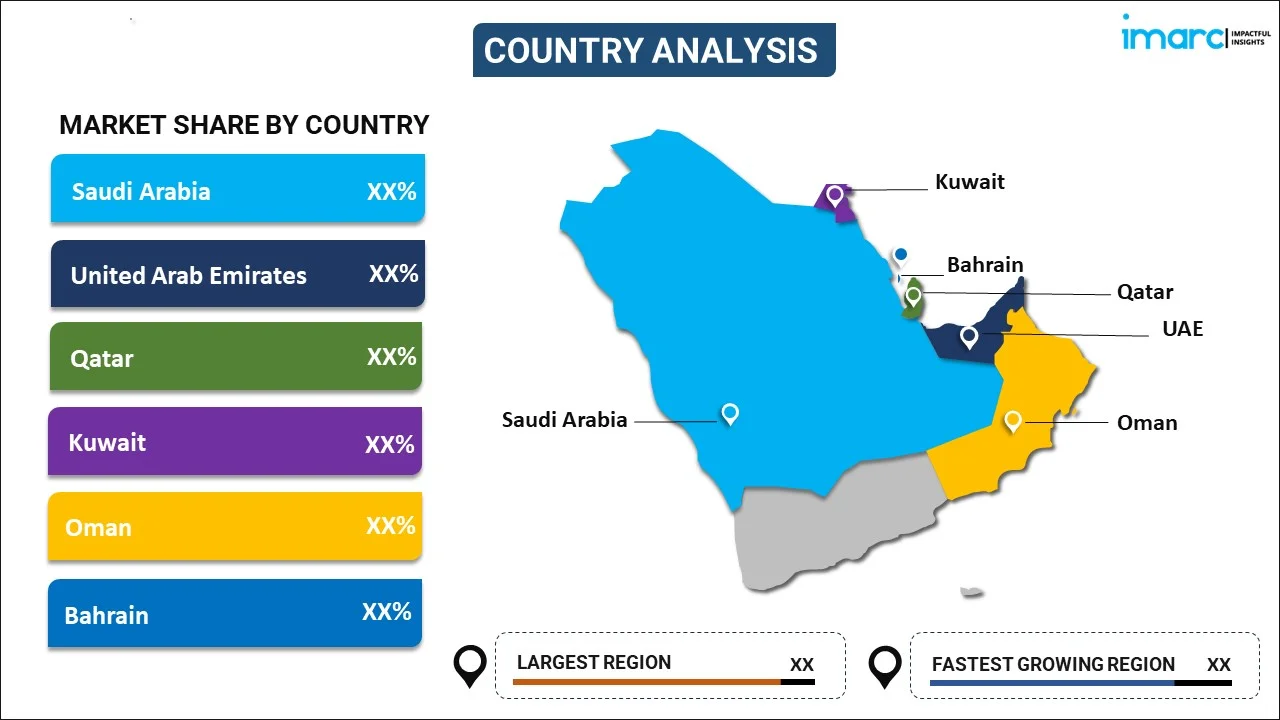
GCC Kosher Food Market Report by Type (Buckwheat, Seafood, Lamb, Pulses, and Others), Application (Culinary Products, Snacks and Savory, Bakery and Confectionery Products, Meat, Beverages, Dietary Supplements), Distribution Channel (Supermarkets and Hypermarkets, Grocery Stores, Online Stores), and Country 2025-2033
Market Overview:
The GCC kosher food market size reached USD 424 Million in 2024. Looking forward, IMARC Group expects the market to reach USD 615 Million by 2033, exhibiting a growth rate (CAGR) of 4.2% during 2025-2033. The growing understanding of kosher food’s benefits, increasing influx of tourists in the region, implementation of several initiatives and regulations by the regional governments, increasing exposure of the regional government to global culinary trends, and escalating emphasis on sustainability and ethical consumerism represent some of the key factors driving the market.
|
Report Attribute
|
Key Statistics
|
|---|---|
|
Base Year
|
2024 |
|
Forecast Years
|
2025-2033
|
|
Historical Years
|
2019-2024
|
| Market Size in 2024 | USD 424 Million |
| Market Forecast in 2033 | USD 615 Million |
| Market Growth Rate (2025-2033) | 4.2% |
Kosher food refers to food products that comply with the Jewish dietary regulations of kashrut. These dietary laws define the types of food that may be consumed, as well as the ways in which they are prepared and combined. It includes challah, matzo, fish patties, potato pancakes, baked casserole, kosher pickles, falafel, hummus, chickpea dip, beet soup, sweet stew, dumplings, filled crepes, fruit and nut mixture, and filled pastries. They are prepared using carefully sourced ingredients under strict guidelines for slaughter, cleanliness, purity, and quality. Kosher food finds extensive applications across various sectors, such as households, hospitality, healthcare, retail, food services, transportation, education, public spaces, industrial areas, and special events. It aids in enhancing food safety, improving hygiene, supporting the ethical treatment of animals, aligning with specific dietary needs, increasing quality control, and ensuring consistency with religious beliefs. In addition, kosher food provides several advantages, such as suitability for lactose intolerant individuals, reduction in cross-contamination, adherence to health-conscious trends, appeal to vegan and vegetarian diets, and better shelf life.
GCC Kosher Food Market Trends:
The growing understanding of kosher food's benefits, particularly regarding quality and hygiene, is boosting the market growth. Furthermore, the product's alignment with religious beliefs among Jewish and non-Jewish communities is contributing to the market growth. Additionally, the perceived health benefits of kosher food and its suitability for specific dietary needs, such as lactose intolerance, are positively influencing the market growth. Besides this, the increasing influx of tourists in the region with diverse dietary requirements is prompting food establishments to cater to kosher preferences. Moreover, the implementation of several initiatives and regulations by the regional governments promoting food safety and ethical practices are further bolstering the market growth. Apart from this, the increasing exposure of the regional population to global culinary trends, coupled with rising cultural exchange, is positively impacting the market growth. Along with this, the escalating emphasis on sustainability and ethical consumerism, which is encouraging kosher food production, is supporting the market growth. In addition to this, continuous innovation and technological advancements in food processing and packaging, which aids in enhancing product quality, maintaining freshness, and retaining nutritional values, are boosting the market growth. Furthermore, the growing affluence in the GCC region and the willingness to spend on quality food products, such as kosher food, is favoring the market growth. Moreover, the expanding retail and e-commerce platforms that are providing easier accessibility to kosher food products are catalyzing the market growth.
GCC Kosher Food Market Segmentation:
IMARC Group provides an analysis of the key trends in each segment of the GCC kosher food market report, along with forecasts at the regional and country levels for 2025-2033. Our report has categorized the market based on type, application, and distribution channel.
Type Insights:

- Buckwheat
- Seafood
- Lamb
- Pulses
- Others
The report has provided a detailed breakup and analysis of the market based on the type. This includes buckwheat, seafood, lamb, pulses, and others.
Application Insights:
- Culinary Products
- Snacks and Savory
- Bakery and Confectionery Products
- Meat
- Beverages
- Dietary Supplements
The report has provided a detailed breakup and analysis of the market based on the application. This includes culinary products, snacks and savory, bakery and confectionery products, meat, beverages, and dietary supplements.
Distribution Channel Insights:
- Supermarkets and Hypermarkets
- Grocery Stores
- Online Stores
The report has provided a detailed breakup and analysis of the market based on the distribution channel. This includes supermarkets and hypermarkets, grocery stores, and online stores.
Country Insights:

- Saudi Arabia
- UAE
- Qatar
- Bahrain
- Kuwait
- Oman
The report has also provided a comprehensive analysis of all the major regional markets, which include Saudi Arabia, UAE, Qatar, Bahrain, Kuwait, and Oman.
Competitive Landscape:
The report has also provided a comprehensive analysis of the competitive landscape in the market. Competitive analysis such as market structure, key player positioning, top winning strategies, competitive dashboard, and company evaluation quadrant has been covered in the report. Also, detailed profiles of all major companies have been provided.
GCC Kosher Food Market Report Coverage:
| Report Features | Details |
|---|---|
| Base Year of the Analysis | 2024 |
| Historical Period | 2019-2024 |
| Forecast Period | 2025-2033 |
| Units | Million USD |
| Scope of the Report | Exploration of Historical and Forecast Trends, Industry Catalysts and Challenges, Segment-Wise Historical and Predictive Market Assessment:
|
| Types Covered | Buckwheat, Seafood, Lamb, Pulses, Others |
| Applications Covered | Culinary Products, Snacks and Savory, Bakery and Confectionery Products, Meat, Beverages, Dietary Supplements |
| Distribution Channels Covered | Supermarkets and Hypermarkets, Grocery Stores, Online Stores |
| Countries Covered | Saudi Arabia, UAE, Qatar, Bahrain, Kuwait, Oman |
| Customization Scope | 10% Free Customization |
| Post-Sale Analyst Support | 10-12 Weeks |
| Delivery Format | PDF and Excel through Email (We can also provide the editable version of the report in PPT/Word format on special request) |
Key Questions Answered in This Report:
- How has the GCC kosher food market performed so far and how will it perform in the coming years?
- What has been the impact of COVID-19 on the GCC kosher food market?
- What is the breakup of the GCC kosher food market on the basis of type?
- What is the breakup of the GCC kosher food market on the basis of application?
- What is the breakup of the GCC kosher food market on the basis of distribution channel?
- What are the various stages in the value chain of the GCC kosher food market?
- What are the key driving factors and challenges in the GCC kosher food market?
- What is the structure of the GCC kosher food market and who are the key players?
- What is the degree of competition in the GCC kosher food market?
Key Benefits for Stakeholders:
- IMARC’s report offers a comprehensive quantitative analysis of various market segments, historical and current market trends, market forecasts, and dynamics of the GCC kosher food market from 2019-2033.
- The research study provides the latest information on the market drivers, challenges, and opportunities in the GCC kosher food market.
- Porter's five forces analysis assist stakeholders in assessing the impact of new entrants, competitive rivalry, supplier power, buyer power, and the threat of substitution. It helps stakeholders to analyze the level of competition within the GCC kosher food industry and its attractiveness.
- Competitive landscape allows stakeholders to understand their competitive environment and provides an insight into the current positions of key players in the market.
Need more help?
- Speak to our experienced analysts for insights on the current market scenarios.
- Include additional segments and countries to customize the report as per your requirement.
- Gain an unparalleled competitive advantage in your domain by understanding how to utilize the report and positively impacting your operations and revenue.
- For further assistance, please connect with our analysts.
 Inquire Before Buying
Inquire Before Buying
 Speak to an Analyst
Speak to an Analyst
 Request Brochure
Request Brochure
 Request Customization
Request Customization




.webp)




.webp)












